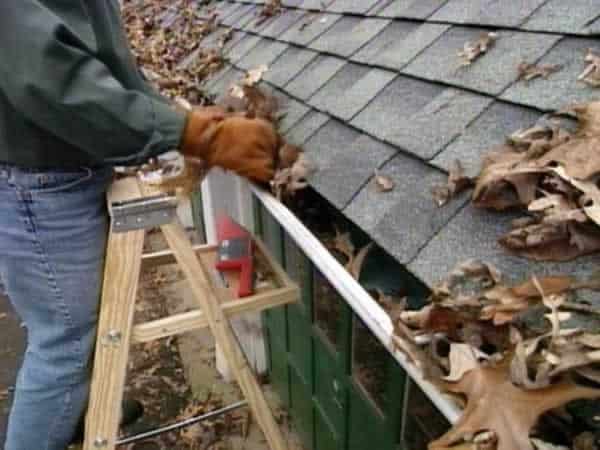To repair cracks in concrete ceilings the most common treatments have to do with the application of waterproofing sheets of different characteristics, which cover the surface, sealing fissures and preventing leaks. They are known as asphalt membrane (or asphalt mantle) and liquid membrane and they are the best solution if you want to waterproof a cement ceiling.
Whichever system you choose to solve the humidity in the roofs, you should start by a good preparation of the surface of the roof so that the product you choose really acts as a good waterproofing or hire a credible team from Cherry and Clark Roofing.

REPAIR OF ROOF LEAKS: PREPARATION OF THE SURFACE TO BE WATERPROOFED
The first thing that you must take into account to waterproof terraces is to proceed to the deep cleaning of the base of the roof. If there are, remove all remaining waterproofing with brushes, spatulas or other suitable elements. Remove traces of dust, mold, grease or any other dirt that prevents the subsequent sealing of the waterproofing. Wash with water, detergent, and of course, let the entire surface dry properly before proceeding with the sealing. Then we will have to try to identify the cracks and fissures in the roof (causing the leaks), which you suppose have generated the interior humidity stains.
HOW TO SEAL CRACKS IN THE CEILING?
Although it seems obvious to say it, as a first measure to seal fissures and cracks in the roof, you have to choose a dry day, without so much heat, cold or humidity, to favor the work of sealing and waterproofing. Cracks that generate moisture leaks, should be enlarged with a spatula and clean any remaining dust. In this way the sealant will have more “body” or thickness to support the possible movements of these fissures, without detaching.
The market offers special waterproof sealers to repair cracks that usually come in cartridges for application with special guns. If you do not have the applicator, you can also get the waterproof sealer in manual application knobs. Sealed and clean the roof surface, let’s see what both terraces waterproofing systems consist of.
CEILING MEMBRANES (ASPHALT MEMBRANES)
For many years, asphalt membranes (or asphalt blankets) were the most widely used system for waterproofing roofs and repairing wetlands. The idea is to cover the entire roof of the slab and its side walls (loads) to ensure continuity in the waterproofing of the roof. The asphalt membranes are a good way to solve leaks in the roof as they are well placed and pay close attention to the sealing between the different parts of the same and in their union with the walls.
HOW TO PLACE ASPHALT MEMBRANES ON CEILINGS
Basically, the asphalt membranes are sold in rolls of 1m wide by 10m long in thicknesses of 4 to 6mm. There are passable or non-passable and its placement is done using a heat gun or a flame torch with which the edges of the same are heated, superimposing them together to form a single cloth.
As a compliment, the most used roofing membranes have a face with aluminum that is placed upwards, to make sunlight reflect. In this way, it is not only possible to repair dampness but also to favor the thermal insulation of the roof, making the interiors cooler. Regarding the question of whether or not to apply another paint on the surface of the slab roof, the IRAM Standards specify as a recommendation that: the membrane for roofing or asphalt membrane must be placed by the system “all adhered”.







One of my friends has a concrete roof and last year, he had leak issue son his roof. Then he used Liquid Butyl Rubber over it as a sealing agent and got outstanding outcomes. He was so satisfied after using this product that he suggested it to me. I also applied it for my metal roof sealing purposes. It has a high adhesive nature and works very effectively on all kinds of roofing materials. It can be applied at low temperatures (50 degrees), has quicker dry time and a state-of-the-art chemical cross linking process whereby the coating and the surface to which it is applied fuse and become one. I also highly recommend this amazing product to every house owner.
Hi Mark,
if your ceiling is leaking then you must repair the crack on the outside. You could try to seal it with sanitary silicone or liquid rubber from the inside but it isn’t a permanent solution!
Regards,
The Handyman tips team!
We have a six-foor hairline crack in the concrete ceiling of our storage locker on the second below-ground parking level. When it rains or snows, water comes through the crack into the locker in anything from a steady drip to a very small stream.
Is there an applied product that can seal the crack surface of our locker ceiling to prevent it from admiting water?
I always have a leaking ceiling I drilled holes in the ceiling at the source for draining the water out, turned my ac off and the water stopped leaking
It’s hard to tell and visualize the problem just from description! Can you send us few pictures on the following mail: handymantips.org@gmail.com
I have a situation with an suspended concrete porch on the second level which covers a patio below. The client wants to enclose the lower area to create bathroom and sitting room with drywall ceiling under the suspended concrete porch above. How do I ensure that water cannot penetrate the concrete above into the drywalled ceiling below?
The existing concrete’s surface above has been painted with a splatter paint finish which gave a textured finish. Any water proofing application must leave a desirable finish to walk on top of. The upper concrete is covered by a roof and the perimeter is screened in. Pouring rain can enter through the screening and moisten the surface of the concrete.